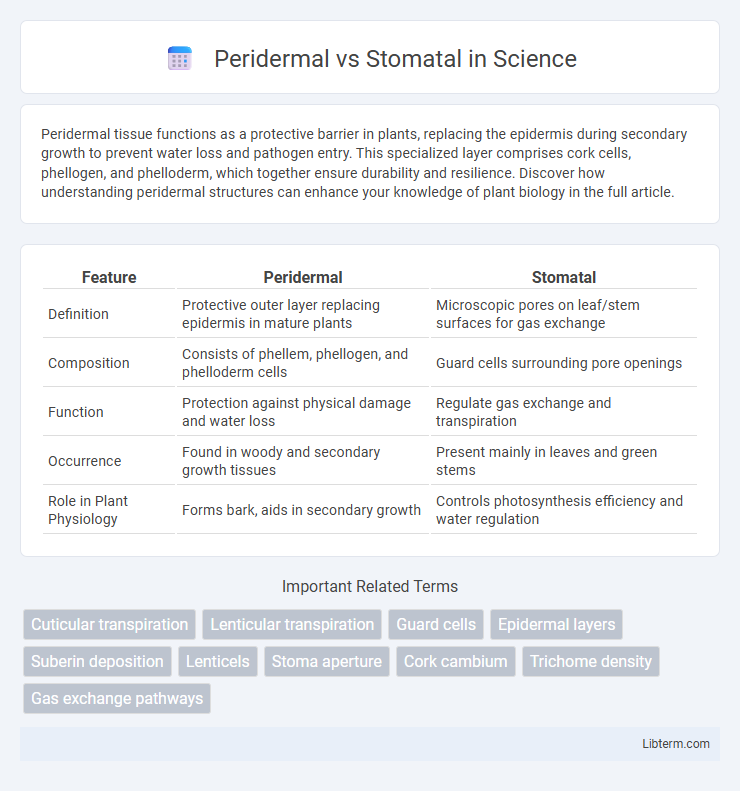Peridermal tissue functions as a protective barrier in plants, replacing the epidermis during secondary growth to prevent water loss and pathogen entry. This specialized layer comprises cork cells, phellogen, and phelloderm, which together ensure durability and resilience. Discover how understanding peridermal structures can enhance your knowledge of plant biology in the full article.
Table of Comparison
| Feature | Peridermal | Stomatal |
|---|---|---|
| Definition | Protective outer layer replacing epidermis in mature plants | Microscopic pores on leaf/stem surfaces for gas exchange |
| Composition | Consists of phellem, phellogen, and phelloderm cells | Guard cells surrounding pore openings |
| Function | Protection against physical damage and water loss | Regulate gas exchange and transpiration |
| Occurrence | Found in woody and secondary growth tissues | Present mainly in leaves and green stems |
| Role in Plant Physiology | Forms bark, aids in secondary growth | Controls photosynthesis efficiency and water regulation |
Introduction to Peridermal and Stomatal Tissues
Peridermal tissues form the protective outer layer in plants, primarily replacing the epidermis during secondary growth to prevent water loss and protect against pathogens. Stomatal tissues consist of specialized guard cells that regulate gas exchange and transpiration by opening and closing stomata on the leaf surface. Peridermal tissue is mainly composed of cork cells, while stomatal tissue is integral to photosynthesis and respiration processes.
Definition of Peridermal Tissue
Peridermal tissue is a protective secondary tissue in plants that replaces the epidermis during secondary growth, consisting mainly of cork cells, cork cambium, and phelloderm. It functions to safeguard internal tissues from physical damage and water loss while allowing gas exchange through lenticels. Unlike stomatal tissue, which includes pores for gas exchange in the epidermis, peridermal tissue forms a tougher, more durable outer layer crucial for woody plant survival.
Definition of Stomatal Tissue
Stomatal tissue consists of specialized cells forming pores called stomata, primarily found on the epidermis of plant leaves and stems, facilitating gas exchange and transpiration. Each stoma is surrounded by guard cells that regulate its opening and closing, controlling the movement of oxygen, carbon dioxide, and water vapor. In contrast, peridermal tissue refers to the protective outer layer replacing the epidermis during secondary growth, composed mainly of cork cells, phellem, and phellogen.
Structural Differences Between Peridermal and Stomatal
Peridermal tissue consists of protective layers including the phellem, phellogen, and phelloderm, forming a thick, corky barrier primarily in woody plants. Stomatal structures are microscopic pores surrounded by guard cells on the epidermis, facilitating gas exchange and transpiration. Unlike the multi-layered periderm, stomata are single-cell layer modifications that regulate opening and closing for environmental interaction.
Functional Roles of Peridermal Cells
Peridermal cells form a protective tissue layer in plants, replacing the epidermis during secondary growth and preventing water loss while shielding the underlying tissues from pathogens and mechanical injury. These cells contribute to the development of the bark, providing a robust barrier essential for the plant's longevity and resilience in harsh environments. In contrast, stomatal cells primarily regulate gas exchange and transpiration, facilitating photosynthesis and water vapor release through adjustable pore openings.
Functional Roles of Stomatal Cells
Stomatal cells regulate gas exchange and water vapor release through tiny pores on the leaf surface, playing a crucial role in photosynthesis and transpiration. Unlike the peridermal cells that mainly provide protective functions and prevent water loss through a tough outer layer, stomatal cells actively control opening and closing in response to environmental stimuli such as light, humidity, and CO2 concentration. These dynamic guard cells optimize plant gas exchange efficiency, balancing carbon dioxide uptake for photosynthesis with water conservation under varying conditions.
Peridermal vs Stomatal: Location in Plants
Peridermal structures are located on the outer protective layer of stems and roots, replacing the epidermis during secondary growth to provide protection and reduce water loss. Stomatal openings are primarily found on the epidermis of leaves and young stems, facilitating gas exchange and transpiration. The peridermal layer is thick and protective, whereas stomata are specialized pores embedded in the epidermis for regulating internal gas composition.
Adaptations and Environmental Responses
Peridermal tissues provide protection and water retention in woody plants by forming a tough outer barrier that adapts to environmental challenges such as physical damage and water loss. Stomatal structures regulate gas exchange and transpiration by opening and closing in response to environmental stimuli like light intensity, humidity, and carbon dioxide levels, optimizing photosynthesis and water use efficiency. These adaptations enable plants to maintain homeostasis and survive fluctuating environmental conditions.
Importance in Plant Physiology
Peridermal tissue, consisting of the cork cambium and protective layers, plays a crucial role in preventing water loss and protecting plants from pathogens, while stomatal pores regulate gas exchange and transpiration essential for photosynthesis and respiration. The balance between peridermal protection and stomatal regulation ensures optimal water conservation and gas diffusion needed for plant survival and growth. Effective coordination of these structures maintains homeostasis in varying environmental conditions, impacting overall plant health and productivity.
Summary: Key Differences Between Peridermal and Stomatal
Peridermal tissue acts as a protective outer layer in plants, primarily composed of cork cells that replace the epidermis during secondary growth, while stomatal tissue consists of pores regulated by guard cells to facilitate gas exchange and transpiration. Peridermal structures provide resistance to physical damage and water loss, contrasting with stomata's role in controlling carbon dioxide intake and oxygen release. The key functional distinction lies in periderm's protective barrier function versus stomata's regulatory control of plant respiration and photosynthesis.
Peridermal Infographic

 libterm.com
libterm.com